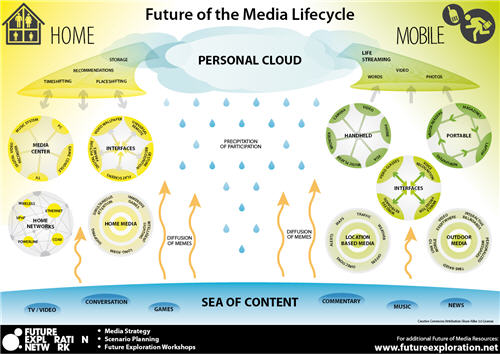Where tablets will fit into the media landscape
Rumors about the forthcoming Apple tablet are heating up. Gizmodo reports that Apple is in discussions with New York Times and other publishers about putting their content on a new device, with a mooted launch date of January. Wired Gadget Lab says to expect a device running the iPhone operating system, with 5-6 times the resolution of an iPhone screen and 7 times the screen size. Techcrunch suggests that the device’s size will mean an on-screen keyboard can be used for touch-typing.
In considering how tablets from Apple or others will be used as a media device, it is useful to refer to our Future of the Media Lifecycle visual from last year.
Click on the image to download full pdf
This shows the lifecycle of media across home and mobile spaces, including how devices and interfaces facilitate the diffusion and creation of content from mainstream media through social media and life streaming and back again in a never-ending cycle.
As shown in the visual, there are two primary device forms that will be used in mobile media.
Handheld devices (perhaps better defined as pocketable devices) have largely converged into single devices (usually called phones) that have many functions. While there will be occasional successes for single-purpose devices, such as the Flip video camera, the process of handheld convergence is largely done, and format advances are more likely to be evolutionary from here.
Portable devices are those that do not fit into a pocket and have to be carried, either by hand or in a bag. This in fact includes current print formats such as newspapers and magazines, though these will gradually be superseded by digital formats. We are far earlier in the convergence and evolution of portable devices than for handheld devices, however we are beginning to get a feel for how this may play out.
The most important factor distinguishing a tablet from a laptop is the lack of a keyboard. As noted by Techcrunch, on-screen keyboards might (or might not) be a complete substitute for physical keyboards on larger screens. In any case many people will use tablets more for media consumption than creation, as they are with iPhones today. While most people are envisaging tablets as slabs, the recently announced Asus eBook provides another possibility: a laptop-style folding device with both sides screens. This has the advantage of increasing screen size relative to device size, and being a very familiar format.
One of the key uncertainties is whether specialist devices such as the Kindle and other ebook readers will play a role in the portable space, or whether general-purpose devices will predominate. This is very hard to predict, as this will depend on the interplay between publishers, ebook distributors, and device manufacturers around digital rights management. It is possible that fears of piracy will keep publishers mainly to dedicated ebook readers. In the short-term, there are a number of required features of ebooks that differ from tablets, notably screen resolution, active vs passive screens, and controllers.
Multi-fold and rollable screens may eventually blur the boundaries between handheld and portable devices, however the technology is not yet mature enough. Interestingly, studies have shown that people are averse to rollable screens as they think they might break them, however familiarity might overcome that issue.
It will be a very interesting few years ahead as the tablet/ portable space evolves.

